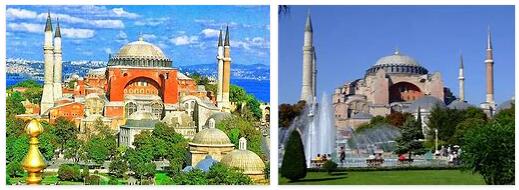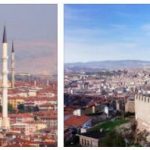Turkey – the country between Orient and Occident! Let yourself be fascinated by Asia Minor, with the ancient sites of Ephesus, Troy, Pergamon and Hierapolis. Discover the city on two continents, Istanbul, with the Blue Mosque, Hagia Sophia, the Chora Church, the Hippodrome, the Theodosian Land Wall, the Sea Wall, the Dolmabahce Palace, the Maiden’s Tower and the legendary Turkish Bazaar on the Bosporus. In the capital Ankara, visit the Museum of Anatolian Peoples and Civilizations, Ataturk’s Mausoleum, the Kocatepe Mosque or the Roman ruins of the Temple of Augustus. Experience Troy, the UNESCO cultural monument, in the plain of Skamander and admire the city walls of Troy. This ancient city, shrouded in legends and myths, will pull you on its way.
Blue Mosque Istanbul
Istanbul and the Blue Mosque – an unforgettable experience
With its magnificent domes and the famous six minarets, the symbol of Istanbul greets residents and guests from afar. It can be seen from almost all parts of the city. Conversely, a fantastic view over the Bosphorus can be enjoyed from there. The Blue Mosque, named Sultanahmet Camii after its builder, is located in the old town in the Sultanahmet district, which is rich in impressive sights. The mosque, built in the 17th century, with its balanced proportions, slender minarets and selected building materials is considered the main work of Ottoman architecture. In terms of size and splendor, it is only surpassed by the mosques in Mecca and Medina.
Why blue
When entering the building from the surrounding small park, the first thing you will see is a courtyard surrounded by small domes. When entering the interior, you immediately understand why the mosque is called the “blue one”. Countless blue tiles, painted with traditional motifs, shimmer iridescent in the light of approx. 250 windows. The breathtaking impression of the room is deepened by the red of the prayer rugs and the impressive candlesticks. The center of the prayer house is an imposing prayer room with an almost square base of approx. 2700 square meters, over which the 43 m high dome arches. The tomb, the Türbe, where Sultan Ahmet I, his wife and three of his sons rest, is also located on the site of the mosque.
A trip to Istanbul is worthwhile at any time of the year. Especially outside of the main tourist season, educational and city travelers will be able to devote themselves intensively to enjoying the many attractions that are significant in terms of art history and urban planning. The Blue Mosque is easy to get to by tram. Afterwards, it is worth exploring the area on foot.
Hagia Sophia
Hagia Sophia translates into German as “Holy Wisdom” and is the name of a world-famous museum in Istanbul, Turkey. It was a Christian church for 916 years and a mosque for 482 years and witnessed the history of Constantinople and the golden age in Byzantium. Until the completion of St. Peter’s Basilica in Rome, it was the largest church in the Christian world.
Hagia Sophia is one of the most popular sights on study trips to Istanbul, Turkey.
History of Hagia Sophia
According to topschoolsintheusa, the basilica was first built in 360, but was destroyed by fire in 404. In 415, Theodosius II ordered a new building, which in 532 under Justinian during the Nika uprising fell victim to the flames again. It was rebuilt in 537 and Hagia Sophia remained a Greek Orthodox cathedral until the end of the Byzantine Empire. In 1453 it became a Roman Catholic church until it fell victim to the Ottomans under Fatih Sultan Mehmet, who held Friday prayers in Hagia Sophia on June 3, 1453 and turned it into a mosque.
In 1935, the Republic of Turkey converted Hagia Sophia into the most famous museum in Istanbul, which is a must for every trip to Istanbul.
Interior of the Hagia Sophia
The splendid interior of the Hagia Sophia gives an idea of the power it has held throughout history: marble slabs from the marble quarries in Anatolia, bricks and roof tiles from Rhodes for the uniquely generous dome, imposing columns from Asia Minor, Greece and Italy.
The variety of mosaics depicting religious scenes, saints or cross motifs combined with the Ottoman influence, which aligned the prayer niche to Mecca, had 4 minarets, a cistern, a madrasah and a courtyard, show the historical growth of this church. The incident light is reflected in the golden mosaics. Through the walling up of many windows and the loss of mosaics, the current semi-darkness was created, which has something mystical about it.




